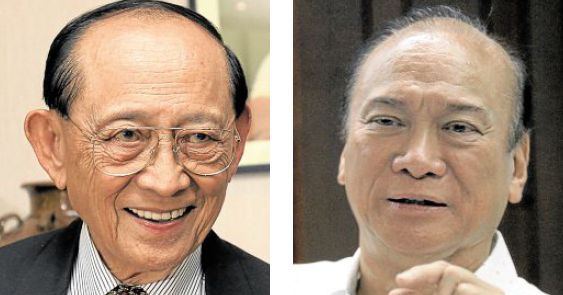
The late former President Fidel V. Ramos and former Sen. Ramon Magsaysay Jr., son of the late President Ramon Magsaysay. (FILE PHOTOS)
MANILA, Philippines — Fidel Valdez Ramos, known as FVR or Eddie, was a “warrior” who was open to negotiations with the “enemy” to achieve the goal they both sought.
His father, the diplomat and erstwhile journalist Narciso Ramos, and mine, the late President Ramon Magsaysay, became friends when they were both members of Congress in 1946 after the end of the Second World War.
When Eddie came home after graduating in 1950 from the prestigious US Military Academy in West Point, New York, and obtaining a Master of Science in Civil Engineering degree from the University of Illinois, my father, who was then the secretary of the Department of National Defense asked the newly minted lieutenant to be his aide-de-camp.
But young Eddie politely turned down the offer. He told my father, “Mr. Secretary, I am sorry but I’d like to go to combat.”
Eddie would get his wish when, as a 21-year-old military officer, he volunteered to go to Korea as a member of the 20th Battalion Combat team of the Armed Forces of the Philippines during the Korean War from 1950 to 1953.
‘Just call me Eddie’
Upon his return to the Philippines, he would be involved in the campaign against what was originally called the Hukbong Bayan Laban sa Hapon (Hukbalahap). Later known simply as Huks, members of the group would carry out a rebellion against the government after WWII.
I would not meet FVR again until 1981 when we were building our respective homes in Ayala Alabang Village, Muntinlupa City. He owned the lot adjacent to my own on a small street.
I was happy to have General Ramos, then chief of the Philippine Constabulary and deputy chief of staff of the Armed Forces of the Philippines, as my neighbor.
When I addressed him as “General,” he immediately replied, “Just call me Eddie.”
When the late Corazon Aquino stepped down as president after six years in office following the People Power Movement in 1986, Eddie, then a retired general, decided to run to succeed her. It was a crowded field of seven aspirants.
FVR, representing the Lakas-NUCD (Partido Lakas ng Tao and National Union of Christian Democrats), narrowly defeated Miriam Defensor Santiago of the People’s Reform Party. He got the lowest plurality in Philippine election history and his victory registered the closest margin of victory, percentage-wise, until the 2004 presidential election.
‘Minority’ mindset
Eddie was mindful that he was a minority president so reconciliation and collaboration with his rivals topped his agenda after he assumed the office of the President.
He called them and asked them to set aside political differences and to work with him and support his agenda to improve the lives of Filipinos.
During his term, President Ramos took steps that helped stabilize and push the growth of the Philippine economy, so much so Encyclopedia Britannica would say of him: “He was generally regarded as one of the most effective presidents in that nation’s (Philippines) history.”
Eddie had integrity and, the “warrior” that he was, was a man of action. But he was not impulsive. He was very good at planning what he wanted to do.
Before he made any decision, he wanted to get all the information available and would do his own research. After he had acquired a thorough grasp of the situation or the problem then he acted fast. We would all learn to appreciate later the political legacy of President Eddie for his handling of economic issues.
A snappy salute for a “warrior” President.
RELATED STORIES
Farewell to FVR: Ming thanks nation for the love
Fidel V. Ramos, 94: Stabilizer in chief
‘Steady Eddie’ hailed for upholding PH democracy, economy